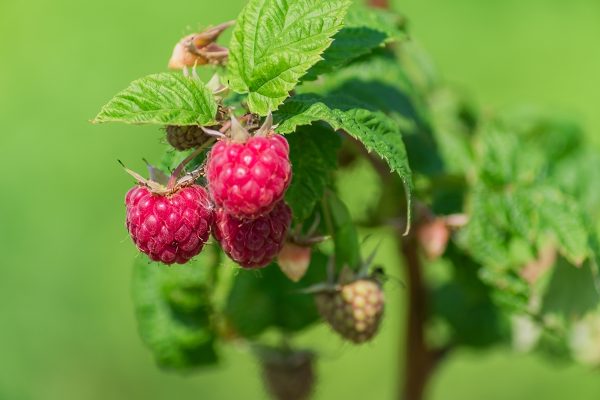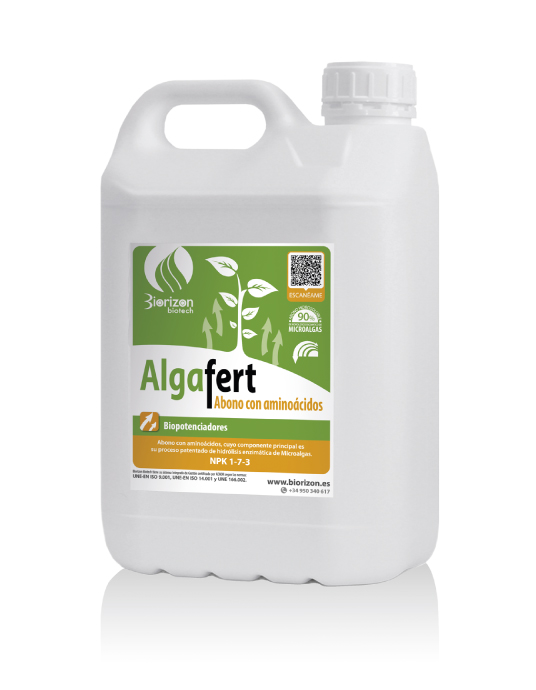
Red fruits

Estudio de Algafert Eco para lechugas
Tests and results
Red fruits

Climate and Soil Requirements in Changing Times
Soft fruit crops have specific climatic and soil requirements. Climate change, with its extreme temperatures and more frequent weather events, presents considerable challenges. Strawberries, for example, require a cool period for good production, while high temperatures can affect fruit formation in raspberries and blueberries. In addition, drought episodes have a direct impact on fruit development, affecting fruit size and quality.
As for the soil, berries thrive in well-drained soils rich in organic matter. However, climate change also brings with it blocked soils, which hinder the absorption of essential nutrients. The water retention capacity of the soil is compromised, affecting water availability for plants. Addressing these challenges involves management practices adapted to the new climatic conditions, such as efficient irrigation systems and amendments to improve soil structure.
Soft fruit crops face a number of complex challenges related to climate, nutrition, pests, regulations and market demands. Addressing these challenges requires specific solutions that address environmental, nutritional and commercial needs, seeking sustainability and efficiency in the production of healthy, high quality food.
Red Fruit Crops and their Representative Varieties
Soft fruit crops, which include strawberry, raspberry, blueberry and blackberry, are an essential part of the fresh fruit supply. Among the most representative varieties are strawberry 'Camino Real', raspberry 'Heritage', blueberry 'Bluecrop' and blackberry 'Triple Crown'. Each of these varieties brings unique flavors and distinctive characteristics, making berries popular and versatile choices.

Physiopathologies and Nutritional Disorders in Soft Fruit Crops
Pathophysiological and nutritional disorders are common threats to soft fruit crops. Crown rot in strawberries, caused by fungi, can weaken plants and reduce crop quality. Iron chlorosis in raspberries, an iron deficiency, affects leaf color and compromises photosynthesis. Boron deficiency in blueberries can result in misshapen fruit and lower productivity, while foliar necrosis in blackberries affects overall plant health.
Proper nutrient management is essential to prevent these problems. Strategies such as controlled application of specific fertilizers and early correction of nutritional deficiencies are key. In addition, the implementation of sustainable agricultural practices, such as crop rotation, can help maintain soil health and prevent nutritional disorders.

Challenges in Pests and Diseases
Soft fruit crops face significant challenges in pest and disease management, especially in the context of increasingly restrictive legislation and growing consumer demand for products with lower pesticide residues. Pollination of strawberries by bees and other natural pollinators is vital, but their exposure to pesticides can have negative consequences. Therefore, it is essential to adopt more selective and sustainable approaches to crop protection.
Integrated strategies, such as the introduction of beneficial insects and targeted application of phytosanitary products, become key tools. Continued research in biological control methods and the development of resistant varieties are crucial to maintain crop health without compromising food safety and final product quality. In addition, consumer awareness of sustainable practices in soft fruit production contributes to greater acceptance and demand for environmentally friendly products.
Producer Needs and Business Challenges
Soft fruit growers face challenges in managing resources, such as water and nutrients, and must adopt sustainable practices to meet environmental standards. Efficient marketing in a competitive market, together with price variability and seasonal demand, add complexity to the commercial management of these crops.
Post-harvest challenges and market demands
While this section originally focuses on postharvest challenges in citrus, for soft fruits, preserving freshness and quality after harvest is vital. The need to reduce food waste and meet consumer demands for fresh and healthy products poses specific challenges in post-harvest handling and logistics.
RED FRUIT

Red Fruit Crops and their Representative Varieties
Soft fruit crops, which include strawberry, raspberry, blueberry and blackberry, are an essential part of the fresh fruit supply. Among the most representative varieties are strawberry 'Camino Real', raspberry 'Heritage', blueberry 'Bluecrop' and blackberry 'Triple Crown'. Each of these varieties brings unique flavors and distinctive characteristics, making berries popular and versatile choices.
Climate and soil requirements in changing times
Soft fruit crops have specific climatic and soil requirements. Climate change, with its extreme temperatures and more frequent weather events, presents considerable challenges. Strawberries, for example, require a cool period for good production, while high temperatures can affect fruit formation in raspberries and blueberries. In addition, drought episodes have a direct impact on fruit development, affecting fruit size and quality.
As for the soil, berries thrive in well-drained soils rich in organic matter. However, climate change also brings with it blocked soils, which hinder the absorption of essential nutrients. The water retention capacity of the soil is compromised, affecting water availability for plants. Addressing these challenges involves management practices adapted to the new climatic conditions, such as efficient irrigation systems and amendments to improve soil structure.

Physiopathologies and Nutritional Disorders in Red Fruits
Pathophysiological and nutritional disorders are common threats to soft fruit crops. Crown rot in strawberries, caused by fungi, can weaken plants and reduce crop quality. Iron chlorosis in raspberries, an iron deficiency, affects leaf color and compromises photosynthesis. Boron deficiency in blueberries can result in misshapen fruit and lower productivity, while foliar necrosis in blackberries affects overall plant health. Proper nutrient management is essential to prevent these problems. Strategies such as controlled application of specific fertilizers and early correction of nutritional deficiencies are key. In addition, the implementation of sustainable agricultural practices, such as crop rotation, can help maintain soil health and prevent nutritional disorders.

Challenges in Pests and Diseases
Soft fruit crops face significant challenges in pest and disease management, especially in the context of increasingly restrictive legislation and growing consumer demand for products with lower pesticide residues. Pollination of strawberries by bees and other natural pollinators is vital, but their exposure to pesticides can have negative consequences. Therefore, it is essential to adopt more selective and sustainable approaches to crop protection. Integrated strategies, such as the introduction of beneficial insects and targeted application of phytosanitary products, become key tools. Continued research in biological control methods and the development of resistant varieties are crucial to maintain crop health without compromising food safety and final product quality. In addition, consumer awareness of sustainable practices in soft fruit production contributes to greater acceptance and demand for environmentally friendly products.
Producer needs and business challenges
Soft fruit growers face challenges in managing resources, such as water and nutrients, and must adopt sustainable practices to meet environmental standards. Efficient marketing in a competitive market, together with price variability and seasonal demand, add complexity to the commercial management of these crops.
Post-harvest challenges and market demands
While this section originally focuses on postharvest challenges in citrus, for soft fruits, preserving freshness and quality after harvest is vital. The need to reduce food waste and meet consumer demands for fresh and healthy products poses specific challenges in post-harvest handling and logistics.

Lorem ipsum dolor sit amet, consectetur adipiscing elit, sed do eiusmod tempor incididunt ut labore et dolore magna aliqua. Ut enim ad minim veniam, quis nostrud exercitation ullamco laboris nisi ut aliquip ex ea commodo consequat. Duis aute irure dolor in reprehenderit in voluptate velit esse cillum dolore eu fugiat nulla pariatur. Excepteur sint occaecat cupidatat non proident, sunt in culpa qui officia deserunt mollit anim id est laborum.
Lorem ipsum dolor sit amet, consectetur adipiscing elit, sed do eiusmod tempor incididunt ut labore et dolore magna aliqua. Ut enim ad minim veniam, quis nostrud exercitation ullamco laboris nisi ut aliquip ex ea commodo consequat. Duis aute irure dolor in reprehenderit in voluptate velit esse cillum dolore eu fugiat nulla pariatur. Excepteur sint occaecat cupidatat non proident, sunt in culpa qui officia deserunt mollit anim id est laborum.


Lorem ipsum dolor sit amet, consectetur adipiscing elit, sed do eiusmod tempor incididunt ut labore et dolore magna aliqua. Ut enim ad minim veniam, quis nostrud exercitation ullamco laboris nisi ut aliquip ex ea commodo consequat. Duis aute irure dolor in reprehenderit in voluptate velit esse cillum dolore eu fugiat nulla pariatur. Excepteur sint occaecat cupidatat non proident, sunt in culpa qui officia deserunt mollit anim id est laborum.
















